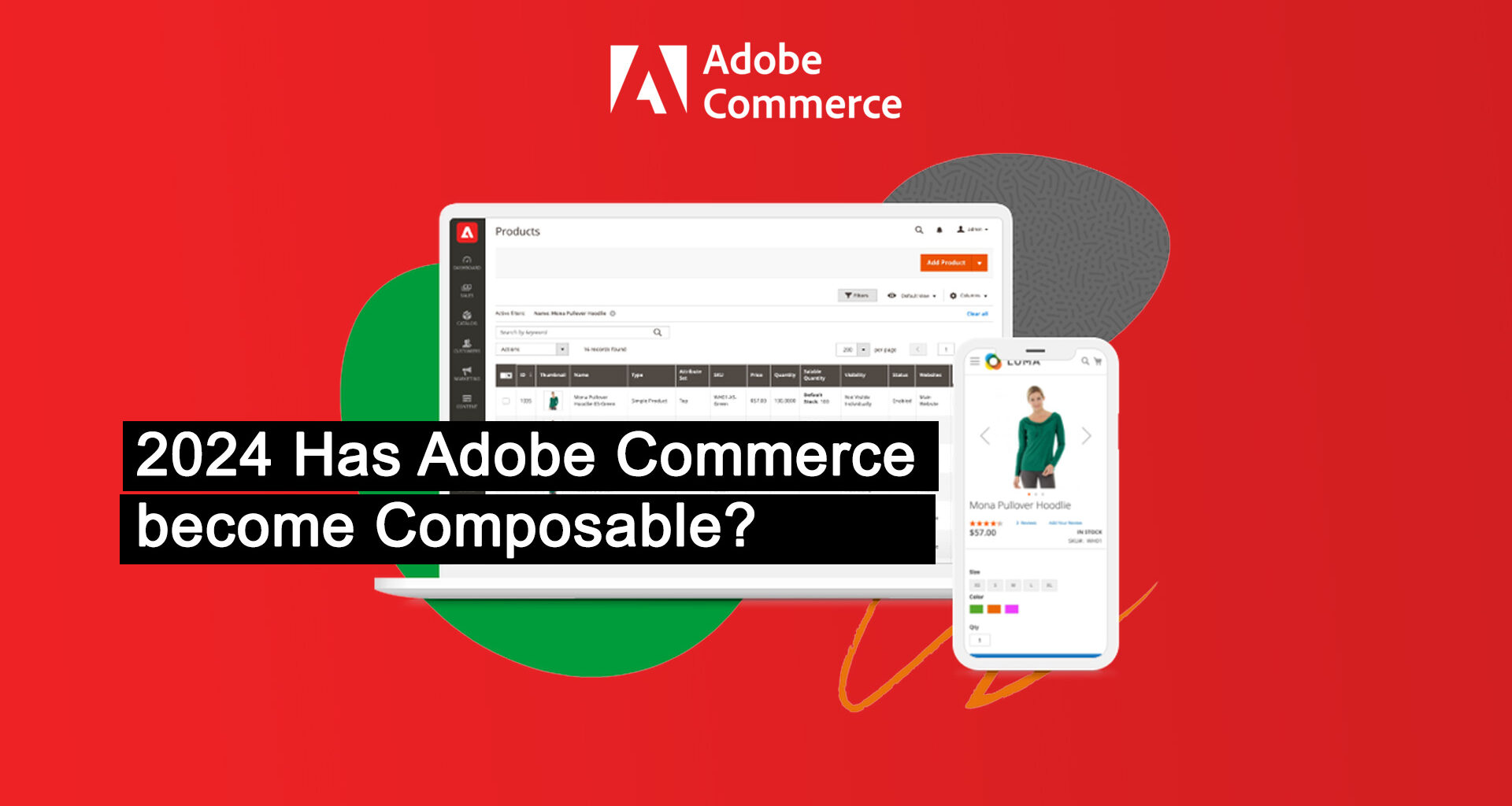Adobe Commerce has taken a significant step forward in the world of composable commerce with its February 2024 product update. This update showcases the platform’s commitment to innovation, flexibility, and user-centricity, as it bolsters AI-powered personalization, simplifies composable development tools, and introduces HIPAA-compliant solutions for the healthcare industry. In this article, we’ll explore how Adobe Commerce is transforming into a true composable commerce solution and discuss the key features that make it stand out.
But first, let’s go back to the beginnings.
The History of Magento to Adobe Commerce
- Magento: The Early Years (2008-2018)
- Magento Open Source (previously Magento Community Edition) was launched, providing a flexible and scalable platform for merchants. It was widely seen as a competitive option for other solutions at the time.
- The community stepped onboard and drove the innovation of what was then to a large degree a completely open source platform. The introduction of a marketplace accelerated this innovative power and module developers sprung up like mushrooms.
- Magento Enterprise Edition was introduced and offered advanced features and support for larger businesses.
- The platform continued to gain popularity due to its modular architecture, extensive community support, and a wide range of extensions.
- Adobe Acquisition and Transformation (2018-Present):
- Adobe acquired Magento in 2018 for $1.68 billion, integrating it into the Adobe Experience Cloud, expanding its capabilities in digital marketing and analytics.
- The focus shifted towards creating a seamless omnichannel experience, with the introduction of features like Adobe Live Search and Payment Services.
- The latest update emphasizes composable commerce, enabling merchants to mix and match best-of-breed solutions.
- Composable Commerce: A New Frontier:
- Adobe Commerce now offers a modular and extensible platform, allowing merchants to build custom solutions tailored to their needs.
- The introduction of Edge Delivery Services and App Builder promotes agility and flexibility, while simplifying development and integration.
Does Adobe Commerce fulfil the necessary Composable Commerce criteria?
- Composable Development Tools:
- Adobe Developer App Builder: Introduced in 2023, this tool revolutionizes the way developers build on Adobe Commerce, enabling faster launches, seamless data sharing, and reduced customization costs.
- Enhanced Webhooks: Now configurable through the UI and triggerable conditionally, these tools allow for more control over third-party integrations.
- Pre-built ERP Integrations: Adobe is expanding its integration starter kit to include Microsoft Dynamics 365 Finance and SAP S/4HANA, reducing the time and cost of back-office integrations.
- AI-Powered Personalization:
- Live Search: Updated with AI algorithms for more personalized search results and category merchandising, Live Search now offers customizable UI features and improved re-ranking rules.
- Adobe Real-Time CDP: Enhanced data connections allow for deeper personalization across the customer journey, with expanded audience activation capabilities.
- Healthcare Industry Focus:
- HIPAA Compliance: Adobe Commerce now offers HIPAA-specific data handling capabilities, catering to healthcare businesses and ensuring secure, personalized experiences while maintaining compliance.
- Payment Services Expansion:
- Interchange ++ Pricing and headless compatibility signal Adobe’s commitment to competitive payment solutions.
- Integration with Apple Pay and support for incremental payments like PayPal Pay In 4 further streamline the payment process.
- B2B Commerce Updates:
- Request for Quote enhancements and child accounts streamline complex B2B operations, reflecting Adobe’s understanding of the industry’s needs.
- Edge Delivery Services:
- A new high-performance storefront, Edge Delivery Services, promises extreme content velocity and agility, with modular architecture optimized for composable commerce.
Pros of Adobe Commerce
- Comprehensive Feature Set: Offers a wide range of built-in features, including B2B capabilities, payment services, and personalization tools.
- Integration with Adobe Suite: Seamless integration with Adobe Experience Cloud products, enabling a unified customer experience.
- Scalability: Supports businesses of all sizes, from small startups to large enterprises.
- Strong Community and Partner Ecosystem: A vast network of developers, agencies, and extensions to support customization and growth.
Cons of Adobe Commerce
- Cost: Adobe Commerce can be more expensive compared to open-source alternatives, especially for enterprise-level plans.
- Steep Learning Curve: The platform’s complexity can be challenging for less experienced users and developers.
- Customization Overhead: While composable, customizing the platform can require significant development resources.
- Licensing and Upgrades: Ensuring compliance with licensing terms and managing upgrades can be a concern for some merchants.
The Future of Adobe Commerce
So what does the future hold? A platform that by some measures has fallen behind the adoption of true SaaS solutions such as Shopify. I don’t think anyone should underesdtimate the innovative power of Adobe. It’s after all the company that’s brought us many world-leading software that’s stood the test of time, Photoshop, Reader, InDesign, Premiere, After Effects and many many more. Adobe’s commitment to innovation, an underlying composable architecture, and now AI-driven personalization certainly indicates a promising future for the platform.
As the e-commerce landscape continues to evolve, Adobe Commerce is poised to adapt and shape market demands.
Conclusion
While it’s still early to draw any concrete conclusions, it seems very clear that Adobe has a commitment to continue the journey from Magento to a leading composable commerce solution. This is mostly reflected by their drive to innovate and listen to merchant and partner needs.
For anyone looking to replatform to Adobe Commerce, I’d say that while the platform today offers numerous advantages, some composable in nature, it’s essential to weigh the costs and complexities against the benefits when considering it for your business. With a strong ecosystem and continuous development, Adobe Commerce remains a compelling choice for merchants seeking a powerful and adaptable e-commerce platform. The future will determine whether it’s a composable one or not.









